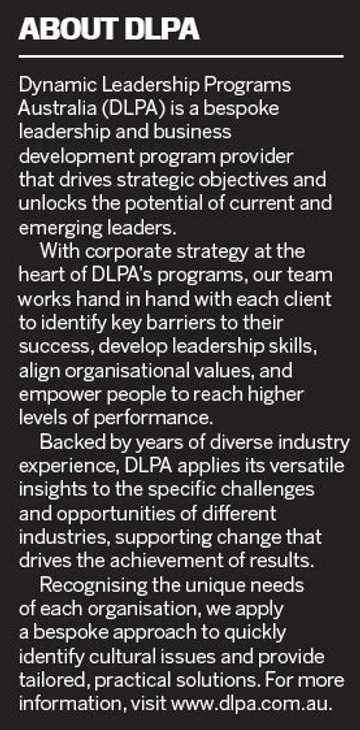Diversity and inclusion are moving beyond simple corporate buzzwords and finally starting to drive active policy within organisations
For Karlie Cremin, owner and director of Dynamic Leadership Programs Australia (DLPA), diversity and inclusion are much more than words to be tacked on to an annual report; they’re approaches to the workplace that deeply inform the consulting services she provides to her clients.
“The truth is that we all need to go beyond ticking the box,” says Cremin. “Businesses who don’t embrace it in a meaningful way are going to get left behind, both as employers and marketplace performers.”
In practical terms, Cremin notes, a diversity and inclusion policy serves multiple purposes. Perhaps the first and most obvious from a strictly business perspective is that it makes good financial sense. There is hard data around this too: research from McKinsey indicates that gender-diverse companies are 15% more likely to outperform their peers, and ethnically diverse companies are 35% more likely to do the same. Catalyst research shows that companies with more women on their boards statistically outperform their peers over a long period of time. Additionally, Deloitte Australia research shows that inclusive teams outperform their peers by 80% in team-based assessments.
Business aside, there are moral and ethical considerations, Cremin explains. Companies should understand and reflect the communities they serve, or hope to serve. Perhaps most importantly, the modern emphasis on diversity and inclusion is also a means – if an imperfect one – of redressing past inequalities and lack of opportunities for marginalised communities in the workplace.
But how can HR leaders craft an effective strategy for increasing diversity within their organisations?
“If you don’t have a clear purpose at the heart of your strategy, it’s unlikely to be successful” Karlie Cremin, director, DLPA
Cremin points out that it’s a multifaceted process, and quick fixes are unlikely to be effective ones. But as a starting point, she has five key recommendations that organisations should consider before beginning to draft their plans for diversity and inclusion.
1. Articulate the ‘why’
It is critical to clearly articulate your ‘why’ to the wider organisation, says Cremin. Not only will it enable other staff to more effectively embrace such an initiative, but it will also provide clarity, guidance and motivation, helping them to stay the course and providing a focal point.
Similarly, successful communication is not just about broadcasting on social media channels and handing out glossy brochures. Consider how you are going to ensure the messaging from your managers and supervisors in their conversations and interactions with their teams is going to deliver the outcome you want, and increase coordinated effort.
“The big problem we see is that many organisations fail to properly articulate why they’re trying to bring more diversity to their workplace,” she says. “But as with any other area of business, if you don’t have a clear purpose at the heart of your strategy it’s unlikely to be successful.”

2. Avoid tokenism
While Cremin is positive about the potential that minimum quotas can have for increasing diversity within organisations, she’s well aware of the risk of tokenism.
“One of the real risk factors for tokenism is when gestures or attempts towards diversity happen in silos or are seen as piecemeal,” she says.
What’s needed is a coordinated strategy from the beginning, to help reduce this risk. It’s crucial to include in your strategy how you are going to set your workers up for success once hired – and importantly, communicate the wider vision to the current workforce.
“Rather than running a message like ‘We need to have two workers in X category by next week’, try focusing on the bigger context,” says Cremin. “For example, you might frame the conversation along the lines of ‘We are committed to having 25% female representation by 2024’, or ‘We want to be different from our competitors so we can be market leaders’.”
3. Start small
When it comes to introducing new diversity and inclusion measures, there is often a temptation to roll out significant changes in one fell swoop, Cremin says. On paper that sounds nice – and can certainly make for good PR – but it can also increase stress among the existing workforce and even contribute to lower rates of uptake over the long term.
“I tend to recommend starting small with diversity initiatives,” she says. “However, you do need to have clear time frames and a plan for scalability: how will you take lessons learned during these early stages and achieve your goals within that time limit?”
Starting small also enables you to gain insight into what will work in your particular organisational setting. In many cases, it will highlight areas where changes need to be made internally to allow for greater diversity. The aim is to encourage overall improvement, notes Cremin.
“You want to set the focus to a positive long-term view,” she says, “not into an ‘if this doesn’t work straight away, we’ll just give up’ mentality.”
4. Focus on structure
Building a strong strategy is one thing, Cremin says, but having the internal structures to support it is entirely another. To be truly effective, a successful diversity and inclusion strategy needs to articulate the structures that will be put in place to support success. This will vary from organisation to organisation but will likely include cross-cultural training, mentoring systems, training and development, reporting structures and process design.
“The advantage of improving your structure is that all of these items can also be used to support the workforce as a whole,” says Cremin.
“They’ll also create an environment where diversity can add value to your organisation and not just meet quotas.”
“Businesses who don’t embrace diversity in a meaningful way are going to get left behind” Karlie Cremin, director, DLPA

5. Measure and adjust
The best-laid plans will often implode on contact with the outside world. But this doesn’t mean that planning is a waste of time; rather, it means that tools must be put in place to measure progress and adjust as the situation within your workplace changes.
“Diversity is not a set-and-forget proposition,” says Cremin. “You must articulate and define how you will measure whether the strategy is being successfully implemented. What parameters are you setting? How you will collect and report this data?
Critically, how can you feed this information back to the organisation in a substantial and meaningful way?
“Adjusting and fine-tuning workplace activities on the basis of data is a staple of modern business. With robust metrics and data, you’re able to keep your strategy relevant and maintain the highest chance of success.”
Cremin doesn’t deny that diversity and inclusion is a complex arena for organisations to work in. However, she emphasises that if your organisation is truly committed to reaping the benefits of a diverse organisation, it is imperative you have a robust strategy that supports the success of individual staff members – and, in turn, the entire business.
“Creating diversity isn’t done overnight,” says Cremin. “But if you take it seriously and use these ideas as a jumping-off point before you draw up your strategy, you’ll be heading in the right direction. It really can work if you’re willing to do the work.”
This article was first published on www.hcamag.com.

